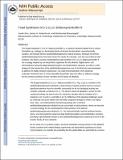| dc.contributor.author | Kim, Justin | |
| dc.contributor.author | Ashenhurst, James | |
| dc.contributor.author | Movassaghi, Mohammad | |
| dc.date.accessioned | 2018-06-27T14:26:12Z | |
| dc.date.available | 2018-06-27T14:26:12Z | |
| dc.date.issued | 2009-04 | |
| dc.date.submitted | 2009-01 | |
| dc.identifier.issn | 0036-8075 | |
| dc.identifier.issn | 1095-920 | |
| dc.identifier.uri | http://hdl.handle.net/1721.1/116655 | |
| dc.description.abstract | The alkaloid (+)-11,11′-dideoxyverticillin A [(+)-1] isolated from a marine fungal species has attracted considerable attention because of its highly functionalized and stereochemically complex molecular structure. This ornate dimeric natural product is a member of a large family of epidithiodiketopiperazine alkaloids (Fig. 1), which have been known for (Chemical Equation Presented) their rich biological activity and intricate molecular architecture. The intimidating task of constructing the sterically crowded stereogenic centers and highly sensitive functionalities make these compounds elusive for total synthesis. This study, however, describes a biosynthetically inspired enantioselective first total synthesis of (+)-1 that features stereoselective and chemoselective advanced-stage tetrahydroxylation and tetrathiolation reactions. The retrosynthetic analysis of (+)-1 (Fig. 2) mimics a biosynthesis pathway connecting dimeric epidithiodiketopiperazines to common α-amino acid precursors. The total synthesis of (+)-11,11′-dideoxyverticillin A is detailed in Figure 3. A multigram amount of the dimeric diketopiperazine intermediate (+)-13 was obtained in several steps from commercially available amino acid derivative 9. The hydroxylation of (+)-13 proved to be onerous. After extensive experimentation, Py 2 AgMnO 4 was found to efficiently oxidize (+)-13 to afford tetraol (+)-14 as a single diastereomer in multigram scale. Subsequent derivatization and reduction steps yielded (+)-16, a surrogate of intermediate 6 (Fig. 2). Treatment with trithiocarbonate followed by ethanolamine furnished the desired tetrathiolation product 5, which upon KI 3 treatment finally produced the title compound (+)-1 in 62% yield as a colorless solid. The structure of (+)-1 was unambiguously established by spectroscopic and crystallographic analyses. (Chemical Equation Presented) © 2010 Data Trace Publishing Company. | en_US |
| dc.description.sponsorship | American Society for Engineering Education. National Defense Science and Engineering Graduate Fellowship | en_US |
| dc.description.sponsorship | Fonds québécois de la recherche sur la nature et les technologies (Fellowship) | en_US |
| dc.publisher | American Association for the Advancement of Science (AAAS) | en_US |
| dc.relation.isversionof | http://dx.doi.org/10.1126/science.1170777 | en_US |
| dc.rights | Creative Commons Attribution-Noncommercial-Share Alike | en_US |
| dc.rights.uri | http://creativecommons.org/licenses/by-nc-sa/4.0/ | en_US |
| dc.source | PMC | en_US |
| dc.title | Total synthesis of (+)-11,11′-dideoxyverticillin A | en_US |
| dc.type | Article | en_US |
| dc.identifier.citation | Kim, J., et al. “Total Synthesis of (+)-11,11’-Dideoxyverticillin A.” Science, vol. 324, no. 5924, Apr. 2009, pp. 238–41. | en_US |
| dc.contributor.department | Massachusetts Institute of Technology. Department of Chemistry | en_US |
| dc.contributor.mitauthor | Kim, Justin | |
| dc.contributor.mitauthor | Ashenhurst, James | |
| dc.contributor.mitauthor | Movassaghi, Mohammad | |
| dc.relation.journal | Science | en_US |
| dc.eprint.version | Author's final manuscript | en_US |
| dc.type.uri | http://purl.org/eprint/type/JournalArticle | en_US |
| eprint.status | http://purl.org/eprint/status/PeerReviewed | en_US |
| dc.date.updated | 2018-01-30T19:24:39Z | |
| dspace.orderedauthors | Kim, Justin; Ashenhurst, James A.; Movassaghi, Mohammad | en_US |
| dspace.embargo.terms | N | en_US |
| dc.identifier.orcid | https://orcid.org/0000-0003-3080-1063 | |
| mit.license | OPEN_ACCESS_POLICY | en_US |
